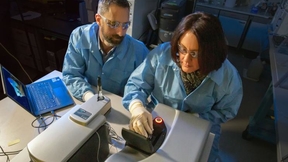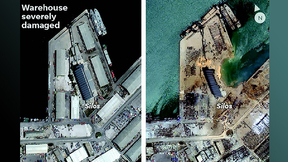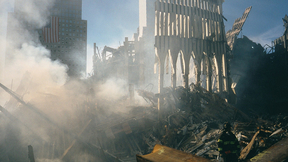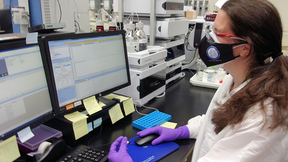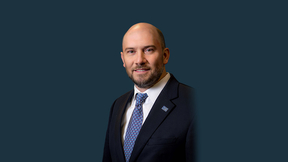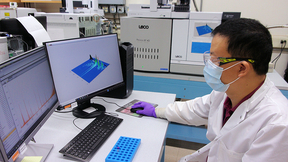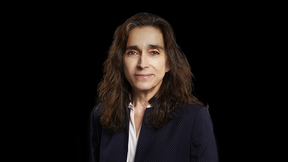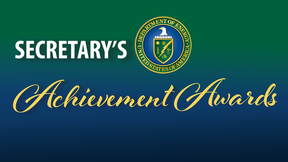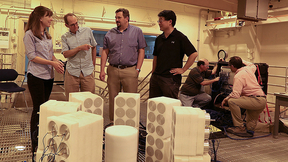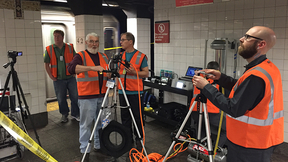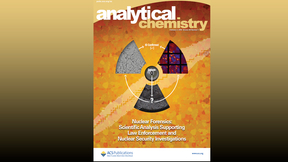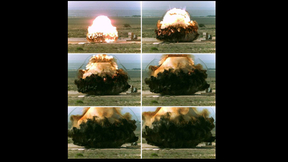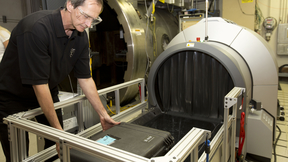Back
Physicist Tom Ramos has had several roles for the past 40 years at Lawrence Livermore National Laboratory. He served as a member of the nuclear team that developed the X-ray laser for President Reagan’s Strategic Defense Initiative, he supported United States arms control negotiations for START, and over a span of seventeen years he created and ran a program for the…
Scientists from Lawrence Livermore National Laboratory (LLNL) and three other institutions are seeking to develop a multi-pathogen vaccine that will protect against three bacterial biothreat pathogens. Led by LLNL, the team includes disease experts from the University of New Mexico Health Sciences Center (UNMHSC), the University of Nevada, Reno School of Medicine (UNR Med)…
When Daniel Martin put the finishing touches on an autonomous vehicle robot, complete with an ultrasonic sensor to detect and evade obstacles, he knew he wanted to become an engineer. A high school student at the time, he was fascinated by the design and functionality of robots. Fast forward several years, and Martin is now a second-year electrical engineering Ph.D…
On Aug. 4, 2020, one of the largest non-nuclear explosions in history pulverized a Beirut port and damaged more than half the city. The explosion resulted from the detonation of tons of ammonium nitrate, a combustible chemical compound commonly used in agriculture as a high-nitrate fertilizer, but which can also be used to manufacture explosives. Since that time, the…
Editor's note: The following is part of a series of articles looking back at the Lab's response immediately following the Sept. 11 attacks and our contributions since that day 20 years ago. Wayne Shotts was asleep when the phone rang on the morning of Sept. 11, 2001. His wife Jacki picked it up. It was their son, Ken. He sounded panicked. “Where’s dad?” Ken asked. Shotts,…
Editor's note: The following is part of a series of articles looking back at the Lab's response immediately following the Sept. 11 attacks and our contributions since that day 20 years ago. As part of its mission to make the world a safer place through science and technology, Lawrence Livermore National Laboratory (LLNL) works to help the nation prevent and mitigate…
It wasn’t an easy road, but Lawrence Livermore National Laboratory (LLNL) Forensic Science Center scientists earned an “A” grade in the Organisation for the Prohibition of Chemical Weapons’ (OPCW) recent biomedical proficiency test. In addition to the usual complexity of the sample preparations and analysis, the Livermore scientists received their proficiency test samples…
Bradley Wallin has been named Lawrence Livermore National Laboratory’s (LLNL’s) principal associate director (PAD) for Weapons and Complex Integration (WCI), Lab Director Kimberly Budil announced today. In this role, Wallin will lead the Laboratory's nuclear weapons program in its responsibilities to support U.S. strategic deterrence by assuring the safety, security and…
This fall, a score of scientists from Lawrence Livermore National Laboratory's (LLNL) Forensic Science Center (FSC) will start two weeks of long days to undertake the Organisation for the Prohibition of Chemical Weapons (OPCW) environmental proficiency test. Livermore scientists have been taking the proficiency tests each October since 2001, with LLNL serving as one of two…
Kim Budil has been named director of Lawrence Livermore National Laboratory (LLNL). Charlene Zettel, chair of Lawrence Livermore National Security, LLC (LLNS), which manages the Laboratory for the Department of Energy's (DOE) National Nuclear Security Administration (NNSA), made the announcement to Laboratory employees Jan. 28. Budil will begin her new role on March 2…
Lawrence Livermore National Laboratory (LLNL) employees, participating in 10 project teams, recently earned Department of Energy (DOE) Secretary Achievement Awards. Representing some of the highest internal, non-monetary recognition that DOE employees and contractors can receive, these awards recognize DOE employees and contractors for their service and contributions to…
The Project on Nuclear Gaming (PoNG) is hosting an online playfest for its first game, SIGNAL, a video game focused on understanding the issues surrounding nuclear deterrence and strategic stability. Thousands have signed up to play SIGNAL since the public launch in May 2019 and the experimental wargaming concept has been featured in the Bulletin of the Atomic Scientists…
Nuclear emergency teams, safeguards specialists and others may one day benefit from an expanded nuclear fission chain theory and detectors developed by a team of Lawrence Livermore Nationla Laboratory (LLNL) physicists. The Livermore scientists have bolstered their theory for understanding nuclear fission chains -- a cascade of atomic nuclei splitting, each initiated by a…
Lawrence Livermore National Lab (LLNL) researchers took to the New York City subway system May 9-13 to help study how a surrogate for a biological agent, such as anthrax, might disperse throughout the nation’s largest rapid transit system as a result of a terrorist attack or an accidental release. As part of a multi-agency test sponsored by the Department of Homeland…
Two Laboratory scientists have teamed with Australian colleagues to author an overview of nuclear forensics that is featured as the cover story for the Feb. 2 edition of Analytical Chemistry magazine.LLNL analytical chemists Mike Kristo and Ruth Kips, in collaboration with three researchers from the Australian Nuclear Science and Technology Organisation (ANSTO), wrote the…
Lawrence Livermore researchers have determined that a tunnel bomb explosion by Syrian rebels was less than 60 tons as claimed by sources.Using seismic stations in Turkey, Livermore scientists Michael Pasyanos and Sean Ford created a method to determine source characteristics of near-earth surface explosions. They found the above-ground tunnel bomb blast under the Wadi al…
Fans of the popular TV series "CSI" know that the forensics experts who investigate crime scenes are looking for answers to three key questions: "Who did it; how did they do it; and can we stop them from doing it again?"The field of nuclear forensics, an important element of LLNL’s national security mission, has similar goals and uses similar techniques — but with even…
For the second time, Lab physicist Roger White, a designer in B-Division from the Weapons and Complex Integration (WCI) Directorate, has received an award from the Defense Threat Reduction Agency (DTRA) for his work in post-detonation nuclear forensics.White was named the "top contributor of the quarter" for the third quarter of the fiscal year 2013 (April-June, 2013) for…
LIVERMORE, Calif. - Researchers from Lawrence Livermore National Laboratory (LLNL) and the Swiss Federal Institute of Technology (ETH) in Zurich have developed a new method of using nanotubes to detect molecules at extremely low concentrations enabling trace detection of biological threats, explosives and drugs. The joint research team, led by LLNL Engineer Tiziana Bond…
Each time you step on a commercial flight, you can feel safer because of a researcher you've probably never heard of. His name is Harry Martz. He's a veteran scientist at the Lawrence Livermore National Laboratory (LLNL) who wakes up every day thinking how his research can advance X-ray imaging technology to thwart the next terrorist attack. See the video .Plainspoken and…


